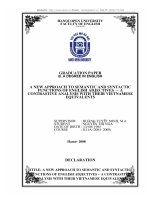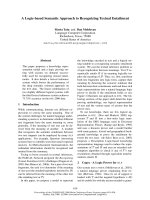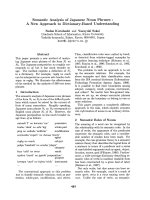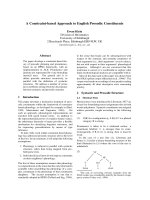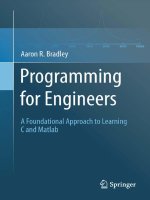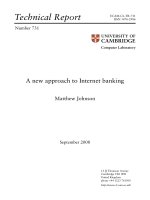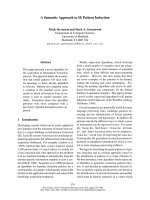A semantic approach to english grammar by r m w dixon
Bạn đang xem bản rút gọn của tài liệu. Xem và tải ngay bản đầy đủ của tài liệu tại đây (4.25 MB, 562 trang )
oxford textbooks in linguistics
Series editors
Keith Brown, Eve V. Clark, April McMahon, Jim Miller, and Lesley Milroy
A Semantic Approach to English Grammar
Second Edition
Ox f o r d T e x t b o o k s i n L i n g u i s t i c s
General editors: Keith Brown, University of Cambridge; Eve V. Clark, Stanford University;
April McMahon, University of SheYeld; Jim Miller, University of Auckland;
Lesley Milroy, University of Michigan
This series provides lively and authoritative introductions to the approaches, methods, and
theories associated with the main subWelds of linguistics.
Published
The Grammar of Words
An Introduction to Linguistic Morphology
by Geert Booij
A Practical Introduction to Phonetics
Second edition
by J. C. Catford
Meaning in Language
An Introduction to Semantics and Pragmatics
Second edition
by Alan Cruse
Principles and Parameters
An Introduction to Syntactic Theory
by Peter W. Culicover
A Semantic Approach to English Grammar
by R. M. W. Dixon
Semantic Analysis
A Practical Introduction
by CliV Goddard
Cognitive Grammar
An Introduction
by John R. Taylor
Linguistic Categorization
Third edition
by John R. Taylor
In preparation
Pragmatics
by Yan Huang
Diachronic Linguistics
by Ian Roberts
A Semantic Approach to English
Grammar
Second Edition
R. M. W. Dixon
1
3
Great Clarendon Street, Oxford ox2 6dp
Oxford University Press is a department of the University of Oxford.
It furthers the University’s objective of excellence in research, scholarship,
and education by publishing worldwide in
Oxford New York
Auckland Cape Town Dar es Salaam Hong Kong Karachi
Kuala Lumpur Madrid Melbourne Mexico City Nairobi
New Delhi Shanghai Taipei Toronto
With oYces in
Argentina Austria Brazil Chile Czech Republic France Greece
Guatemala Hungary Italy Japan Poland Portugal Singapore
South Korea Switzerland Thailand Turkey Ukraine Vietnam
Oxford is a registered trade mark of Oxford University Press
in the UK and in certain other countries
Published in the United States
by Oxford University Press Inc., New York
ß R. M. W. Dixon 1991, 2005
The moral rights of the author have been asserted
Database right Oxford University Press (maker)
First edition published 1991 by Oxford University Press as
A New Approach to English Grammar on Semantic Principles
(reprinted Wve times)
Revised and enlarged second edition Wrst published 2005
All rights reserved. No part of this publication may be reproduced,
stored in a retrieval system, or transmitted, in any form or by any means,
without the prior permission in writing of Oxford University Press,
or as expressly permitted by law, or under terms agreed with the appropriate
reprographics rights organization. Enquiries concerning reproduction
outside the scope of the above should be sent to the Rights Department,
Oxford University Press, at the address above
You must not circulate this book in any other binding or cover
and you must impose this same condition on any acquirer
British Library Cataloguing in Publication Data
Data available
Library of Congress Cataloging in Publication Data
Data available
Typeset by SPI Publisher Services, Pondicherry, India
Printed in Great Britain on acid-free paper by
Biddles Ltd., King’s Lynn, Norfolk
ISBN 0–19–928307–9 978–0–19–928307–1
ISBN 0–19–924740–4 (Pbk.) 978–0–19–924740–0 (Pbk.)
1 3 5 7 9 10 8 6 4 2
Contents
List of tables
xii
How to read this book
Preface
xiii
xiv
List of abbreviations
xvii
Part A Introduction 1
1. Orientation 3
1.1.
Grammar and semantics 5
1.2.
Semantic types and grammatical word classes
1.3.
Semantic roles and syntactic relations 9
1.4.
The approach followed 12
1.5.
Words and clitics 16
Notes to Chapter 1 18
2.
Grammatical sketch 19
2.1.
Pronouns 19
2.2.
Verb and verb phrase 22
2.2.1. Forms of the verb 22
2.2.2. Verb phrase 24
2.2.3. Verbal systems 25
2.3.
Noun phrase 26
2.4.
Main clauses 27
2.4.1. Imperative clauses 29
2.5.
Adverbial elements 30
2.6.
Relative clauses 32
2.7.
Complement clauses 36
2.8.
Omission of be 53
2.9.
Types of -ing clause 54
2.10. Word derivations 56
2.11. Clause derivations 58
2.11.1. Questions 58
2.11.2. Causatives 59
7
vi contents
2.11.3. Passives 61
2.11.4. Promotion to subject 61
2.11.5. Reflexives 62
2.11.6. Reciprocals 65
2.11.7. HAVE A VERB, GIVE A VERB and TAKE A VERB 66
2.12. Clause linking 67
2.13. Syntactic preferences and constraints 71
2.14. Summary of omission conventions 74
Notes to Chapter 2 77
Part B
The Semantic Types
79
3.
Noun, adjective and verb types 81
3.1.
Types associated with the Noun class 82
3.2.
Types associated with the Adjective class 84
3.2.1. Comparison of adjectives 91
3.3.
Introduction to verb types 93
3.3.1. Subject and object 93
3.3.2. Grammar versus lexicon 95
3.4.
Primary and Secondary verbs 96
4.
Primary-A verb types 102
4.1.
MOTION and REST 102
AFFECT 110
4.2.
4.3.
GIVING 119
4.4.
CORPOREAL 124
4.5.
WEATHER 127
4.6.
Others 128
Notes to Chapter 4 130
5.
Primary-B verb types 131
ATTENTION 131
5.1.
5.2.
THINKING 139
5.3.
DECIDING 143
SPEAKING 146
5.4.
5.5.
LIKING 160
5.6.
ANNOYING 164
5.7.
Others 169
CONTENTS
6.
Secondary verb types 172
6.1. Secondary-A types 172
6.1.1. MODALS and SEMI-MODALS
6.1.2. BEGINNING 177
6.1.3. TRYING 183
6.1.4. HURRYING 186
6.1.5. DARING 187
6.2. Secondary-B types 188
6.2.1. WANTING 188
6.2.2. POSTPONING 195
6.3. Secondary-C types 196
6.3.1. MAKING 196
6.3.2. HELPING 201
6.4. Secondary-D types 202
6.4.1. SEEM 203
6.4.2. MATTER 205
Notes to Chapter 6 206
Part C Some Grammatical Topics
172
207
7.
She is departing for the jungle tomorrow, although the
doctor has been advising against it
Tense and aspect 209
7.1. Basic distinctions 210
7.2. Generic 211
7.3. Future 212
7.4. Present and past systems 215
7.4.1. Perfective verus imperfective 215
7.4.2. Actual versus previous 217
7.4.3. Present versus past 219
7.5. Irrealis and aspect 222
7.6. Back-shifting 223
7.7. Occurrence 225
Notes to Chapter 7 229
8.
I know that it seems that he’ll make me want to describe
her starting to say that she knows that it seems that . . .
Complement clauses 230
8.1. Parentheticals 233
vii
viii contents
8.2.
Meanings of complement clauses 238
8.2.1.
THAT and WH- 238
8.2.2.
THAT and ING 240
8.2.3.
Modal (FOR) TO, Judgement TO, and THAT 242
8.2.4.
The role of for in Modal (FOR) TO complements
8.2.5.
Omitting to from Modal (FOR) TO complements
8.2.6.
Omitting to be from TO complements 253
8.2.7.
ING and Modal (FOR) TO 255
8.2.8.
WH- TO 255
8.2.9.
(FROM) ING 257
8.2.10. Summary 258
8.3. Complement clauses with Secondary verbs 260
8.3.1.
MODALS and SEMI-MODALS 260
8.3.2.
BEGINNING, TRYING, HURRYING and DARING 261
8.3.3.
WANTING and POSTPONING 264
8.3.4.
MAKING and HELPING 268
8.3.5.
SEEM and MATTER 269
8.4. Complement clauses with Primary-B verbs,
and with adjectives 270
8.4.1.
ATTENTION 270
8.4.2.
THINKING 272
8.4.3.
DECIDING 274
8.4.4.
SPEAKING 275
8.4.5.
LIKING, ANNOYING and adjectives 279
8.4.6.
Other Primary-B types 283
Notes to Chapter 8 285
9.
I kicked at the bomb, which exploded, and wakened you up
Transitivity and causatives 286
9.1. The semantic basis of syntactic relations 287
9.2. Prepositions and transitivity 289
9.2.1.
Verbs with an inherent preposition 290
9.2.2.
Phrasal verbs 293
9.2.3.
Inserting a preposition 297
9.2.4.
Omitting a preposition before
non-measure phrases 299
9.2.5.
Omitting a preposition before measure
phrases 303
247
251
CONTENTS
9.3.
Dual transitivity 305
9.3.1. S ¼ A: transitive verbs that can omit
an object 305
9.3.2. S ¼ O pairs: which is basic? 309
9.3.3. Causatives 311
Notes to Chapter 9 315
10.
Our manager’s annoyance at thoughts of residence
rearrangement bears no relation to his assistant’s criticism
of building restrictions
Nominalisations and possession 317
10.1. Possession 317
10.2. Varieties of deverbal nominalisation 322
10.2.1. Nominalisations denoting unit of activity
and activity itself 323
10.2.2. Nominalisations denoting a state or
a property 327
10.2.3. Nominalisations describing a result 328
10.2.4. Object nominalisations 329
10.2.5. Locus nominalisations 332
10.2.6. Agentive nominalisations 333
10.2.7. Instrumental nominalisations 336
10.2.8. Possession of a nominalisation: summary 337
10.3. Derivational processes 338
10.4. Nominalisation of phrasal verbs 343
10.4.1. Agentive nominalisations 344
10.4.2. Unit and activity nominalisations 346
10.5. Nominalisation by semantic type 348
10.5.1. Primary-A types 348
10.5.2. Primary-B types 349
10.5.3. Secondary verbs 351
Notes to Chapter 10 352
11.
The plate, which had been eaten off, was owned by my aunt
Passives 353
11.1. The nature of passive 354
11.2. Which verbs from Primary types may passivise 360
11.3. How verbs from Secondary types passivise 364
11.4. Complement clauses as passive subjects 367
ix
x contents
11.5. Prepositional NPs becoming passive subjects
Notes to Chapter 11 374
369
12.
Yesterday, even the rather clever bishops could not very easily have
sensibly organised a moderately unusual exorcism here
Adverbs and negation 375
12.1.
Adverbs 376
12.2.
Forms and types 379
12.2.1.
Adjective types and derived adverbs 381
12.3.
Positioning 385
12.3.1.
Position ‘A’ and other medial positions 389
12.3.2.
Positions ‘F’ and ‘O’ 392
12.4.
Adverbs modifying NPs 394
12.5.
Adverbs with sentential but not manner function 402
12.5.1.
Time adverbs 405
12.5.2.
Spatial adverbs 410
12.6.
Adverbs with manner but not sentential function 413
12.7.
Adverbs with both sentential and manner function 418
12.8.
Adverbs modifying adjectives and adverbs 422
12.9.
Other properties 423
12.9.1.
Comparatives 423
12.9.2.
An adverb as a complete utterance 426
12.10. Combinations of adverbs 427
12.11. Negation 432
12.11.1. Sentential and manner-type negation 432
12.11.2. Negative attraction 435
12.11.3. Constituent negation 436
12.11.4. Inherently negative verbs 441
12.11.5. Negation and sentential adverbs 441
12.11.6. Complex negators 443
12.11.7. Negative modifier to a noun 444
Notes to Chapter 12 445
13.
What sells slowly, but wears well?
Promotion to subject 446
13.1.
General characteristics 446
13.2.
The circumstances in which promotion is possible
13.3.
Which roles may be promoted 451
Notes to Chapter 13 458
449
CONTENTS
14.
She gave him a look, they both had a laugh and then took a
stroll
GIVE A VERB, HAVE A VERB and TAKE A VERB constructions 459
14.1. Criteria adopted 462
14.2. Syntax 467
14.3. Meaning 469
14.4. Occurrence 476
Notes to Chapter 14 483
Appendix: List of adjective and verb types, with
sample members 484
References
492
Books by R. M. W. Dixon
Index
503
501
xi
List of tables
2.1.
2.2.
2.3.
2.4.
2.5.
5.1.
5.2.
5.3.
5.4.
6.1.
10.1.
12.1.
12.2.
12.3.
12.4.
12.5.
12.6.
12.7.
Pronoun system 20
Mood, reality, modality, tense and aspect 25
Varieties of main clauses 27
Relations and copula complement possibilities for be 28
Syntactic features of complement clauses 52
Syntactic properties of the main ATTENTION verbs 138
Complement clause possibilities for THINKING verbs 144
Syntactic coding of semantic roles for SPEAKING verbs 147
Main grammatical frames for SPEAKING verbs 149
Modality expressed by modals and semi-modals 173
Agentive nominalisation of varieties of phrasal verbs 344
Functions of adverbs derived from adjectival
semantic types 382
Interaction of adverb and nominal derivation 383
Adverbs which modify an NP, and their other properties 397
Adverbs with sentential but not manner function
(and not referring to time or space) 403
Time adverbs 406
Adverbs with manner but not sentential function 414
Adverbs with both sentential and manner function 419
How to read this book
This book is, of course, designed to be read from Wrst to last page. But other
strategies are possible.
Some of Part A (at least Chapter 1) should be read before Part B. Some
of Part B (at least §3.3 and §3.4) should be read before Part C. Within Part
B, Chapter 3 should be read Wrst but Chapters 4, 5 and 6 could be covered
in any order. Within Part C, the chapters can be read in any order.
A reader familiar with the details of English grammar may prefer to skim
over Chapter 2. Note though that §2.7, on complement clauses (which
contains some original analysis), should be read before Chapter 7, on
complement clauses.
Chapters 4–6 go through every semantic type associated with the class
Verb. It is not necessary to study these in detail before looking at some of
the discussions of grammatical topics in Part III.
Preface
When I Wrst became interested in linguistics, in 1961, it was with the idea
that it should be possible to put forward the kind of description and
explanation which is attempted in this book.
I was thinking about the meanings of words and how their grammatical
properties should be a function of those meanings. I thought: there really
ought to be a discipline, perhaps called linguistics, which deals with such
things. Then I found that there actually was a subject called linguistics. It
was not immediately obvious that linguists at the time were interested in the
interrelation between meaning and grammar. Nevertheless, I settled
down—in a state of some excitement—to study the principles of linguistics.
This was at the University of Edinburgh, under the Wne tutelage of Michael
Halliday and Angus McIntosh.
It seemed to me that if I wished properly to understand the methodology
and theory of linguistics, I should try applying it to description of a
previously undescribed language. So I went on my Wrst year of Weldwork
in North Queensland (in 1963–4) studying Dyirbal. After that I struggled
for a while to Wnd a framework in which to present the description of
Dyirbal. I decided that the facts of the language were diYcult enough to
explain without the added impediment of an opaque jargon, and settled for
a straightforward description in terms of the categories that linguists have
evolved over two thousand years. After publishing long grammars of
Dyirbal (1972) and YidiJ (1977b)—plus shorter grammars of three other
Australian languages that were on the brink of extinction—I wrote a
grammar of Boumaa Fijian (1988) and, most recently, a comprehensive
description of Jarawara, a language of the Arawa´ family, spoken deep in
the Amazonian jungle of Brazil (2004a). For all of these endeavours—and
for typological enquiries on topics including ergativity (1979, 1994) and
adjectives (1977a, 2004b)—I followed the time-tested framework of what
has recently come to be called basic linguistic theory.
Occasionally during the 1970s and intensively since the 1980s, I have also
worked on my native language, English, leading to the Wrst edition of this
book (1991) and now this enlarged and revised edition. There are three new
PREFACE
xv
chapters: 7, on Tense and Aspect, 10, on Nominalisation and Possession,
and 12, on Adverbs and Negation. Also added are §1.5, on Clitics, and
§3.2.1, on Comparison of Adjectives. Chapter 2 has been revised and
expanded in a number of places; in §2.1, I mention the new 3rd person
singular human (non-sex-diVerentiated) pronoun they, and its reXexive
themself.
This is not a full grammar of English, or even an exhaustive account of
certain topics in the grammar of English. It attempts to put forward a
semantically oriented framework for grammatical analysis, and to indicate
how this framework can be applied. Many detailed studies could be undertaken, building up from the groundwork I have tried to provide.
Over the past thirty or forty years I have read many descriptions of
English and of other languages and have learnt something from all of them.
I have studied many accounts of bits of English in terms of ‘formal
theories’—which, like all fashions, bloom and fade with such regularity—
and have learnt, in diVerent ways, from that. Formal theories impose a
straitjacket on a language: the formal theory states that every language has
X, where is X in this language? In contrast, basic linguistic theory seeks to
describe a language in its own terms, within a general typological framework. Language is not neat and symmetrical; it is neither necessary nor
desirable to pretend that it is, or to insist that everything should be
accounted for at every level.
I have beneWted from contact with many scholars—through reading
their works, correspondence and discussion; the list is too long to include
here. This book was greatly helped by the four semesters during which I
taught the ‘Advanced Syntax’ course at the Australian National University, in 1980, 1983, 1986 and 1988. I owe a debt to the students taking these
courses—for the ideas they shared, for their scepticism and criticism, and
for their opinions about what they would and wouldn’t say, and why.
A number of people provided most helpful comments on a draft of the
Wrst edition of this book. Thanks are due to Bernard Comrie, Lysbeth
Ford, Rodney Huddleston, Timothy Shopen, Anna Wierzbicka and the
late James McCawley. A number of scholars sent in helpful comments on
the Wrst edition. These include Kim Yun Kyung, who translated the Wrst
eight chapters for a Korean edition (Kim 1995). Kate Burridge, Stig
Johansson, Gerhard Leitner and Per Lysva˚g provided most useful comments on some or all of the three new chapters. Alexandra Aikhenvald read
xvi preface
through the whole draft (old and new chapters) and made the most pertinent and helpful comments.
Of all the people I have read and talked to, the late Dwight Bolinger
stands out, as someone who has approached the sorts of questions which I
consider interesting, in ways that are stimulating and provocative. He
found time in a busy schedule (in 1989) to read parts of this book and, of
course, provided the most pertinent counter-examples and further generalisations. He also oVered a comment that encouraged me more than
anything anyone else said: ‘After going through Part B (Chapters 3–6) I
can appreciate the heroic proportions of your undertaking. It is a conquest
of the linguistic wilderness, backpacking your way through—the only way
to do what other descriptions, conducted at 20,000 feet using a camera
without a focus, have failed to do. The job will take a while, but this is a Wne
beginning.’
Research Centre for Linguistic Typology,
La Trobe University, Melbourne
October 2004
List of abbreviations
For grammatical functions
A
S
O
CS
CC
transitive subject
intransitive subject
transitive object
copula subject
copula complement
Other
NP
VP
noun phrase
verb phrase
In Chapter 12, for adverb positioning
For sentential adverbs
A
F
I
After the Wrst word of the auxiliary. If there is no auxiliary
then immediately before the verb unless the verb is copula
be, in which case it follows the copula.
As Wnal element in the clause.
As initial element in the clause.
For manner adverbs
V
O
Immediately before the verb.
Immediately after the verb, or verb-plus-object if there is
an object.
This page intentionally left blank
Part A
Introduction
This page intentionally left blank
1
Orientation
1.1. Grammar and semantics
5
1.2. Semantic types and grammatical
word classes
7
1.3. Semantic roles and syntactic
relations
1.4. The approach followed
1.5. Words and clitics
9
12
16
This book provides a fresh look at parts of the grammar of English. It pays
particular attention to meaning, considering the diVerent sorts of meanings
words have, and showing how the varying grammatical behaviours of
words are a consequence of their meaning diVerences.
My ‘meaning orientation’ stance is a little novel. In addition, some of the
topics discussed here (especially in Chapters 13 and 14) are scarcely mentioned in regular grammars of English. It could be said that the present
book takes oV from the point where most other grammars end.
The reader will not Wnd here any detailed discussion of the irregular
inXections of verbs or plural forms of nouns, topics which are covered in
standard grammars. A basic knowledge of certain aspects of English grammar is needed for understanding the later part of the book, and these are
presented in Chapter 2 (which does include some original analysis).
There are two approaches to the study of language. That followed here
considers linguistics to be a kind of natural science. Just as there is a single
chemical theory and a single geological theory, so there is a single linguistic
theory, which has gradually evolved over more than two thousand years,
from the great Sanskrit grammar of Pa¯nini and the Greek grammars of
_
Dionysius Thrax and Apollonius Dyscolus to recent grammars by Edward
4
1. ORIENTATION
Sapir and Mary Haas, and contemporary ones by James MatisoV, Nora
England, William Foley, Nicholas Evans, and Alexandra Aikhenvald.
The cumulative theory of linguistics as a natural science has recently been
called ‘basic linguistic theory’, simply to distinguish it from the ever-shifting
panoply of ‘formal theories’ (mentioned below). It provides an inclusive
framework—covering word classes, main and subordinate clauses, underlying and derived forms, structures, systems, and so on—in terms of which
the descriptions of individual languages are cast. There is constant interplay
between theory and description. Some unusual aspect of the grammar of a
previously undescribed language may lead to a revision or extension of the
theory. And theoretical parameters (worked out inductively from examination of the structures of a range of languages) will provide insight into the
underlying structure of a newly considered language. In the present volume,
theoretical ideas are brought in as they assist the central task, of describing
the syntactic and semantic organisation of English.
An alternative approach to language study—not followed here—has
come into fashion during the past few decades. This imitates disciplines
such as politics, economics, philosophy and literary study in having a
number of competing ‘theories’ (many, but not all, emanating from
Chomsky and his former students) each with its own sets of axioms and
limited focus of interest; there is typically a rather exotic ‘formalism’. In
contrast to the cumulative nature of the theory of linguistics as a kind of
natural science, ‘formal theories’ are eclipsing; each is held to be superior to
its predecessors and competitors. ‘Formal theories’ tend to come and go, at
the fancy of their practitioners.
A primary dictum of linguistics as a science is due to Ferdinand de
Saussure: each language must be studied as a whole system, not individual
bits in isolation. Each part has meaning and function and life only with
respect to the whole. ‘Formal theorists’ eschew this most basic principle.
They simply select and examine bits of language data (out of the context of
the full language to which they belong) in connection with some hypothesis
of detail within their ‘formal theory’. People working with a ‘formal theory’
do not attempt to write a complete grammar of a language in terms of their
theory. They say that this is not their aim, and in any case each ‘formal
theory’ is so restricted—and so convoluted—that it would not be possible
to accomplish it.
In the present volume, the use of jargon and symbolisation has been kept
to a minimum on the principle that, in a subject such as scientiWc linguistics,
1.1. GRAMMAR AND SEMANTICS
5
if something can be explained it should be explainable in simple, everyday
language, which any intelligent person can understand. That is not to say
that this book can be read through quickly, like a novel. It is a serious,
scientiWc attempt to explain the interrelations of grammar and meaning;
the reader is advised to proceed slowly and deliberately, thinking carefully
about what is said and often referring back to an earlier discussion (following the cross-references given).
Many modern books on linguistics build up to a grand generalisation,
something which attracts attention at the time but is found, on reXection, to
be a little over glib, to which many exceptions can be given. Language, as a
pattern of human behaviour, does not yield ‘laws’ like those of Newton or
Einstein. It is a complex phenomenon, whose parts intersect in complex
ways. But it does have a principled basis and it is the purpose of this book
to explore this, demonstrating that a large part of the basis concerns
the meanings of words, and of grammatical constructions, and how these
interrelate.
1.1. Grammar and semantics
A language consists of words and grammar. Grammar itself has two parts:
Morphology deals with the structure of words, e.g. the fact that un-friendli-ness consists of four parts (called ‘morphemes’), each of which has a
meaning, and laugh-ing of two morphemes.
If a morpheme is added to a word and yields a word of a diVerent kind
this is called a derivation, e.g. the formation of adjective beautiful from
noun beauty, noun decision from verb decide, verb widen from adjective
wide, and verb untie from verb tie.
If a morpheme just adds some extra element of meaning to a word which
is required by the grammar of the language, then it is called an inXection,
e.g. the verb kill inXects for past tense, becoming killed, and the noun horse
inXects for plural number, becoming horses.
The second component of grammar, syntax, deals with the way in which
words are combined together. In English an adjective must come before a
noun and an article before the adjective—we can get the old lion, which is a
noun phrase (or NP). A verb (or a verb phrase, such as was sleeping) must
in English be preceded by a noun phrase—we get The old lion was sleeping,
which is a clause.
6
1. ORIENTATION
A sentence may consist of just one clause (it is then called a simple
sentence) or it can be a complex sentence, involving several clauses. There
may be a main clause and a subordinate clause, joined to it by a conjunction, which can indicate reason (The old lion was sleeping because he was
exhausted ) or temporal sequence (The old lion was sleeping after eating the
hunter) and so on.
Underlying both words and grammar there is semantics, the organisation
of meaning. A word can have two sorts of meaning. First, it may have
‘reference’ to the world: red describes the colour of blood; chair refers to a
piece of furniture, with legs and a back, on which a human being may
comfortably sit. Secondly, a word has ‘sense’, which determines its semantic relation to other words, e.g. narrow is the opposite (more speciWcally: the
antonym) of wide, and crimson refers to a colour that is a special sort of red
(we say that crimson is a hyponym of red).
Every morpheme has a meaning. The ending -er, added to a verb, may
derive a noun which refers either to the agent (e.g. baker) or else to an
instrument intended for the activity (e.g. mower). Some morphemes have
diVerent meanings with diVerent kinds of word: un- indicates an opposite
quality with an adjective (e.g. kind, unkind), but a reverse action with a verb
(tie, untie).
Meaning is also associated with the way in which words are combined to
make phrases, clauses and sentences. Compare The dog bit the postman and
The postman bit the dog, which involve the same word meanings but quite
diVerent sentence meanings because of the diVerent syntactic arrangements.
As language is used, meaning is both the beginning and the end point.
A speaker has some message in mind, and then chooses words with suitable
meanings and puts them together in appropriate grammatical constructions; all these have established phonetic forms, which motivate how one
speaks. A listener will receive the sound waves, decode them, and—if the
act of communication is successful—understand the speaker’s message.
The study of language must surely pay close attention to meaning. We
consider the meanings of words, and their grammatical properties, and see
how these interrelate. When a speaker of a language encounters a new word
they may Wrst of all learn its meaning, and will then have a fair idea of the
morphological and syntactic possibilities. Or they may Wrst of all learn
something of how to use the word grammatically, and this will help them to
work out its meaning.
